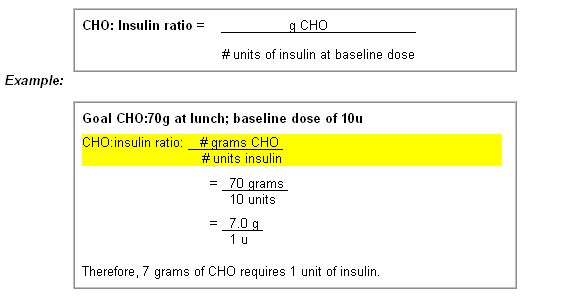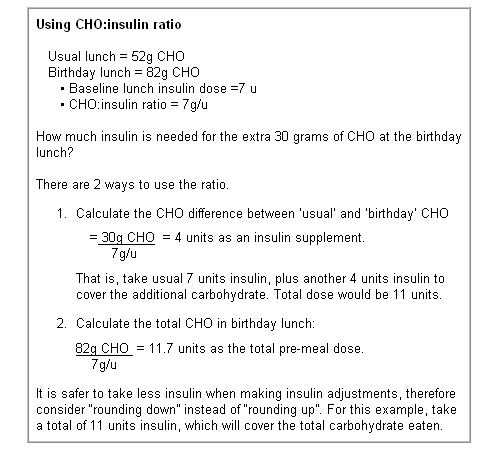Carbohydrate Counting: Frequently Asked Questions
1. Why do I need to set a goal carb per meal?
Keeping a consistent carbohydrate at each meal/snack for a period of time is necessary to determine the correct baseline insulin dose for that specific amount of carbohydrate.
How do I do this?
1. Determine how much carb you typically consume at breakfast, lunch, dinner and snacks (refer to your food records).
2. Set carbohydrate goals for each of the 3 meal periods in a day (breakfast, lunch and dinner).
The total amount of carbohydrate at each meal and each snack is called the goal carbohydrate.
Example:
|
Breakfast |
Grams of Carbohydrate |
Total Carbohydrate |
|
2 slices toast |
30.0 |
|
|
2 tsp/10mL jam |
10.0 |
|
|
1 cup/250mL 1% milk |
12.0 |
|
|
Coffee |
0.0 |
|
|
Total Carbohydrate B’fast |
52.0 |
= goal CHO |
|
Morning Snack |
||
|
1 granola bar |
28.0 |
|
|
1/2 cup/125nL 2% milk |
6.0 |
|
|
Total Carbohydrate Intake |
34.0 |
= goal CHO |
If you use rapid acting insulin, then a carbohydrate goal should be set for each meal and each snack (i.e., 52g carbohydrate at breakfast and 34g carbohydrate at the morning snack).
An insulin injection may be required before snacks in addition to meal insulin. This decision should be based on blood glucose results and in discussion with your diabetes team.
Note: If you use fast-acting insulin (Regular or Toronto), then a carbohydrate goal may be set for each meal period.
An insulin injection at breakfast may cover both the meal and morning snack. An insulin injection may be required before snacks if sugars are above target. Discuss this with your diabetes team.
2. How do I know what insulin dose to give?
- Use Pattern Management to evaluate your baseline insulin doses.
- Start by keeping a consistent amount of carbohydrate at each meal/snack for a period of at least 3 days. This is necessary in order to determine the correct baseline insulin dose for that specific amount of carbohydrate.
- Keep your carbohydrate intake within 3-5 grams of your goal carbohydrate at each meal/snack for those 3 days and assess if the baseline dose is working and meets your blood glucose goals.
How do I know it’s the correct dose?
Your baseline insulin dose is correct when your blood glucose is within your target range at the next blood test for at least two days (given that your goal carbohydrate and activity were consistent).
3. What is a carbohydrate:insulin ratio?
A carbohydrate:insulin ratio is used to determine how much rapid/fast insulin to take for your carbohydrate intake at each meal period.
Why calculate a carbohydrate: insulin ratio?
1. You can use this ratio to adjust the insulin dose to match your food/carb intake.
2. It allows you to have flexibility in your food while having good blood glucose control too.
4. How do I calculate my carbohydrate: insulin ratio?
Once you have determined your baseline (usual) insulin dose and the goal carbohydrate per each meal/snack, then you can calculate a carbohydrate: insulin ratio for each meal and/or snack.
Divide the total amount of carbohydrate (in g/meal) by the amount of insulin required to effectively use that carbohydrate and achieve a BG level that is within the target range.

Now use your carbohydrate: insulin ratio to adjust for the difference in intake.

Key points
- The ratio is only used for fast/rapid insulin taken at meals or snacks.
- Your body may require different amounts of insulin at different times of the day, regardless of food intake. In other words, the ratio may be different for each meal/snack or it could be the same.
And remember, nothing stays the same.
- check your portion sizes to make sure they are accurate
- check your math
- if you are doing everything the same, then you may need to change your baseline insulin dose (remember, when you change the baseline dose, you may also need to change the carbohydrate: insulin ratio)





